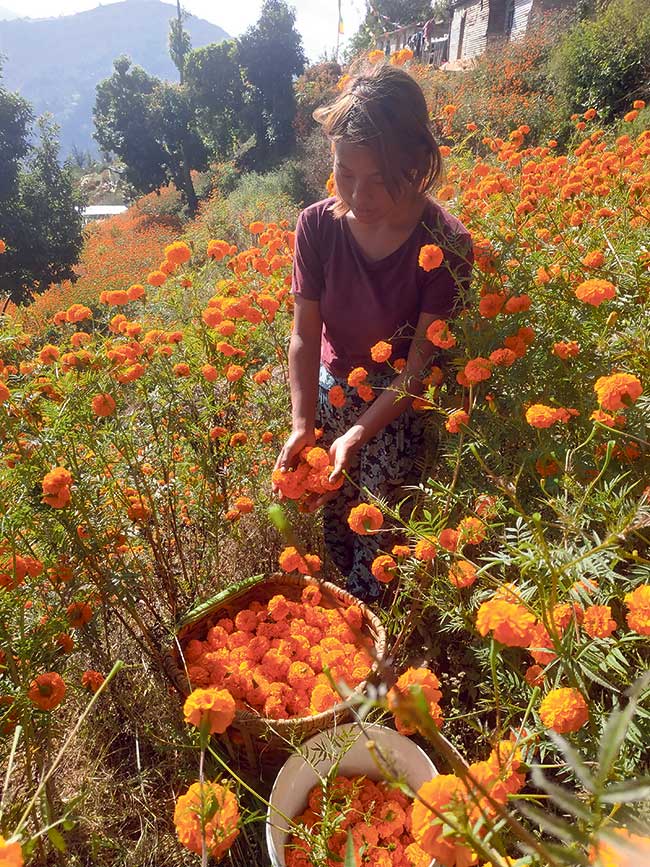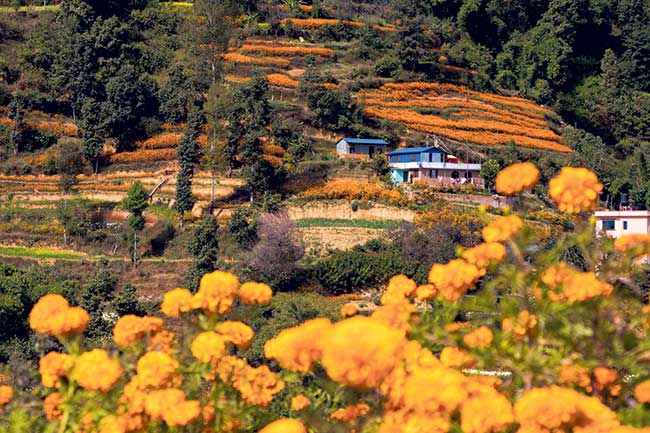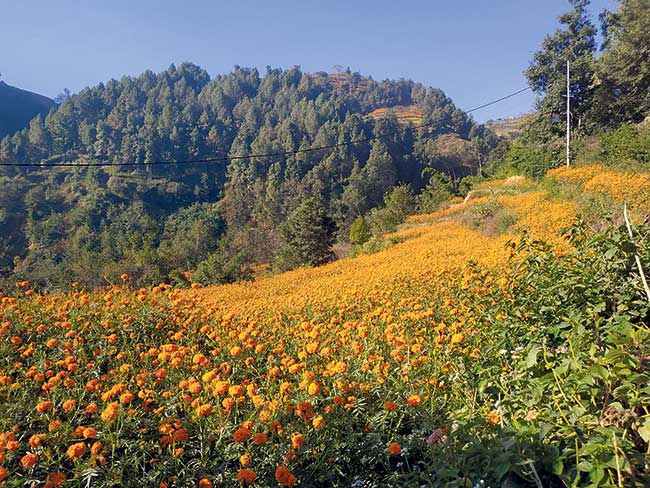KATHMANDU, Nov 5: While children at their surroundings might be making playful pranks with firecrackers, youths rehearsing for Deusi Bhailo and elderly members being occupied with homely chores, many villages of Nagarjun Municipality are growing marigolds to be adorned at the doors and homes of Kathmandu.
Tihar is equally recognized as the festival of colors as it is well-known for glittering lamps and lights. However, at this time of Deepawali approaching near, the hills of Ichangu Narayan and Ramkot are covered with orangey flakes of marigolds.

Since time immemorial, flowering and agriculture have been a heavy source of generating income for the locals of the municipality. Having a fertile land to grow different sort of crops and flowers, massive lands of many villages barely remain barren throughout the year.
Rasaili, Maharjan win golds in karate

Many villages in the municipality largely contribute to the enormous amount of marigolds sold at the crowded markets of Kathmandu including Ason and Swayambhu. A 35-year-old local of Ichangu Narayan, Mailee Shrestha has already welcomed Tihar as she sold the first sack of fresh marigolds for this year.
“Flowering has been our ancestral occupation. We plant a variety of flowers especially the one that has a good price in the market. Although marigolds are planted three times a year, their demand is quite high during Tihar,” said Shrestha. “Before I used to sell a bunch for Rs. 10 but with an increase in the flower supply, the price has eventually dwindled. I now sell three bunches for Rs. 20,” she added.

In a society housed by families of varying ages, some elderly members simply feel the festivals come and go. 80-year-old Suntali Shrestha of Pokhari Daada migrated here with her husband and two daughters over a decade ago. Originally from Sindhupalchok, they migrated and were only able to own a roof above their heads. “We don’t have a land of our own to plant and farm. If we had in the first place, I don’t think our growing age would have allowed us to toil in the fields and farm well,” says Shrestha. “Meanwhile, I fetch mugworts nearby the village, sell them and sustain a living through it. Unlike marigolds they don’t demand care and constant watering,” she adds.
The universal principle of demand and supply are quite comprehensible to the villagers as that seems to determine their income source. Upon knowing that the soil is fertile, every home in the village actively participated to grow a variety of flowers to eventually link it with their economy.
“The flowers not only add beauty to our villages but also encourage us to nurture the beauty through which we earn well and also celebrate the festival.
The concept of agriculture is quite popular at urban areas where people seek unusual and scientific ways to farming and growing crops. However, the freshly bloomed marigolds are too new a concept to be artificially grown in the fields of urban areas,” said 45-year-old Raju Tamang, a local of Ramkot.
“As this year, Dashain and Tihar fell on the month of Kartik, the flowers in most of the houses have grown in good numbers. This has increased the demand and lessened the monetary value of the flowers to be sold this year. When in demand, one dhwang (traditional measuring drum) which equals to 5 pathis of marigolds are sold for prices ranging from Rs. 800 – 1000. However, I am anticipating the price to fall down to around Rs. 400 – 500 this year,” adds Tamang.
 Despite the scarcity of water sources at Ramkot, Raju’s family makes it possible to hydrate the flowers so that they bloom into rights shapes and colors. His wife and daughter-in-law hold the responsibility to carry out the homely chores of watering and nurturing the flowers while Raju carries them to the market and sells them in a certain price.
Despite the scarcity of water sources at Ramkot, Raju’s family makes it possible to hydrate the flowers so that they bloom into rights shapes and colors. His wife and daughter-in-law hold the responsibility to carry out the homely chores of watering and nurturing the flowers while Raju carries them to the market and sells them in a certain price.
“Although the prices are expected to decrease this year we have been receiving increasing demands before the plucking time has arrived. My daughter-in-law along with my sons assist me in gathering and threading the flowers,” expressed Laxmi Tamang.
She further added, “Here, we live Tihar bit by bit every day until the actual day finally arrives. More than a reunion of lights, Tihar is the festivity of flowers for us.”




































